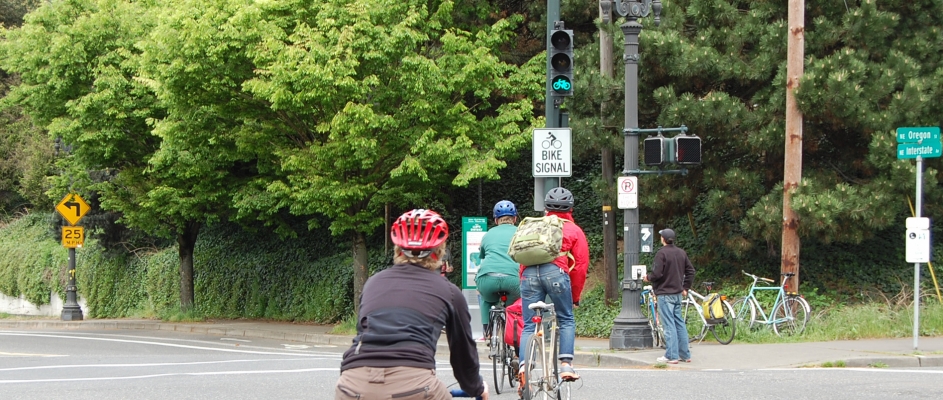Engineering Solutions for Safer Cycling: Bike Signal Timing and Crash Prediction

Addressing Bicycle-Vehicle Conflicts with Alternate Signal Control Strategies -and-
Improving Bicycle Crash Prediction for Urban Road Segments
Sirisha Kothuri, a Portland State University research associate, has recently completed two distinct studies taking different approaches to advancing bicycle safety. Kothuri will lead a Sept. 13 workshop on Bicycle/Pedestrian Focused Signal Timing Strategies along with Peter Koonce, the division manager of Signals & Street Lighting for the City of Portland. The half-day workshop will be part of Transportation and Communities 2018, a two-day intensive training event for transportation professionals.
Traffic signal timing has been a primary focus of Kothuri's for many years. She has conducted extensive research into multimodal safety and efficiency, beginning with her 2014 dissertation which explored Improving Signal Timing for Pedestrians. In 2016 she led a subsequent project on Improving Walkability Through Control Strategies at Signalized Intersections, which was recently published in the May 2018 issue of the Institute of Transportation Engineers (ITE) Journal. Through improving bicycle crash prediction and decreasing bicycle-vehicle conflicts using signal timing, Kothuri's research aims to make urban cycling a safer activity.
Approaching bicycle safety from a signal timing perspective
Addressing Bicycle-Vehicle Conflicts with Alternate Signal Control Strategies, published in April 2018, is the first study to explore bicycle signal control strategies for addressing bicycle-vehicle conflicts. The research team analyzed the operational impacts of traditional signal phasing, leading bike intervals, split leading bike intervals, and exclusive bike phasing in a microsimulation environment. They also analyzed video of real-world bicycle-vehicle conflicts and explored the safety impacts of traditional phasing, leading bike intervals, split leading bike intervals, and mixing zones.
The mixing zones were found to be a source of confusion for both drivers and bicyclists, who seemed unsure of the correct action to take. Researchers observed that a significant percentage of the vehicles merged into the mixing zone at the very last second, thus adding to the confusion.
A common type of crash involving bicycles at intersections is the "right hook," where a right-turning vehicle collides with a bicyclist going through. This study provides broad-based recommendations on how to reduce right-hook conflicts and other safety issues through signal timing treatments such as bicycle-specific signals, exclusive bicycle phases, and leading bike intervals.
This project was supported by the City of Portland, OR, Portland State University, Northern Arizona University, and the City of Flagstaff, AZ.
What other factors lead to a high probability of bicycle crashes?
Improving Bicycle Crash Prediction for Urban Road Segments, published in May 2018, aims at identifying factors that can predict motor vehicle and bicycle crashes—such as motor vehicle volume, facility type, land use and population density—and developing bicycle-specific safety performance measures.
The research team investigated the bicycle-specific crash data in eight potential study areas around the U.S., and dug deeper into the Boulder, CO site for closer analysis. They used a negative binomial model with log link to predict annual non-fatal motorist-bicyclist crashes on road segments per mile– adopting methods from the HSM used for motor vehicle safety performance functions (SPFs).
Their analysis shows that motor vehicle volume is a leading factor. Bicyclist exposure, population density, and percent retail land use are also predictive. While both vehicle volume and bicycle volume data are used in the model in order to account for the “safety in numbers” effect, the model did not demonstrate this effect which is seen commonly in other research, including the bicycle SPF developed previously for intersections in Boulder.
This effort at developing a bicycle-specific SPF for segments in the U.S. which utilizes bicycle volumes is an important first step towards further understanding bicyclist safety, and may inform future versions of the HSM.
This project was funded by the National Institute for Transportation and Communities, with additional support from the Oregon Department of Transportation, Institute for Sustainable Solutions at Portland State University, and University of Colorado Denver.
ABOUT SIRISHA
Sirisha Kothuri earned her Ph.D. from Portland State in 2014 in civil and environmental engineering. NITC has fostered her career since her graduate student days, recognizing her talent and dedication by awarding her a student scholarship in 2013 and supporting her doctoral research when she earned a highly competitive NITC dissertation fellowship.
To learn more about this and other NITC research, sign up for our monthly research newsletter.
RELATED RESEARCH
- Improving Walkability Through Control Strategies at Signalized Intersections
- BikePed Portal Phase II
- Exploring Drivers’ Attitudes and Behaviors toward Bicyclists: The Effect of Explicit and Implicit Attitudes on Self-Reported Safety Behaviors
The National Institute for Transportation and Communities (NITC), one of five U.S. Department of Transportation national university transportation centers, is a program of the Transportation Research and Education Center (TREC) at Portland State University. The NITC program is a Portland State-led partnership with the University of Oregon, Oregon Institute of Technology, University of Utah and new partners University of Arizona and University of Texas at Arlington. We pursue our theme — improving mobility of people and goods to build strong communities — through research, education and technology transfer.
